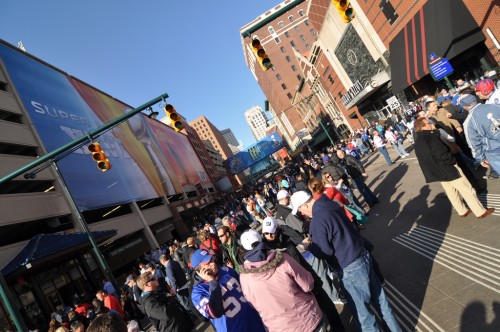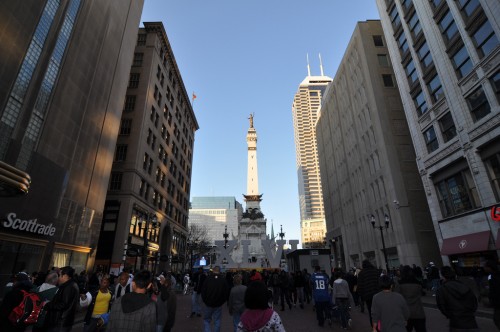
Super Bowl 46 descended on Indianapolis in late January 2012 and the city was ready. As Urban Indy has reported on frequently over the past year, the city was ready with the reconstruction of a 3 block street downtown from a formerly sleepy 4 lane street to a full on pedestrian boardwalk of sorts. Georgia Street was designed to handle the type of events that the Super Bowl would bring with it. Namely, TONS of foot traffic, concerts, street vendors and performers as well as mother nature.

What happened over the two week period can be quantified in one word: AWESOME! Georgia Street played host to over a million visitors and the modifications facilitated an atmosphere and walkability that urban advocates talk about all the time. Additionally, Monument Circle was closed to motor vehicles. It was a frequent visiting place for photographers and tourists alike as lage roman numerals were erected on the plaza fronting South Meridian street. Former Urban Indy member Greg Meckstroth reported on this last year and also extolled the virtues of the concept of the programmed space. In his post he wrote
- The Circle needs more programmed activities and on a regular basis, not just for special events;
- Monument Circle needs a management group that oversees events, programming, maintenance and security. Essentially, they would be in charge of programming the space and raising money and finding sponsors to fund such events
The benefit of programmed spaces was demonstrated for two weeks. The outdoor realm was activated. People mingled. Money changed hands. For the most part, injury and confrontation was avoided and the best parts of experiencing an urban space were on display for all. Even those who don’t necessarily think about urban design gushed poetic about the benefits of being able to walk everywhere while they were in town.

Following the Super Bowl, the city tabbed Indianapolis Downtown Inc to lay out a plan for taking advantage of Georgia Street. A design guide was released (click to open .pdf) that laid out how the 3 block stretch should be developed over time and also created incentives for business owners who spend their own money to modify Georgia Street frontage. What this says is that the City gets it, and wants more of it.
In conclusion, what the long term plan for programming the space will be, and how it might carry over to Monument Circle, remains uncertain. However, Super Bowl 46 demonstrated with 100% accuracy, the power of the programmed space and how a city even as auto centric as Indianapolis, can embrace these changes that enrich the pedestrian experience.
And to add another (long-term) piece of the puzzle is the Pan Am Plaza redevelopment, which seems likely to happen within the next 5 years. Although it will most likely be redeveloped into a hotel/commercial high-rise, I would be most pleased with a residential project there. For all this to work on a non-event day, there needs to be a better mix of residential and commercial.
The IBJ article about this noted that apartments are an option they’re looking at. It’d mesh well with other developments planned for that area — like tearing out the parking lot at Georgia and Penn.
“… Monument Circle was closed to motor vehicles … ” The Circle and the south spoke of Meridian were open Monday-Friday at least during business hours, maybe 24-7, and closed the weekend before and the weekend of the Super Bowl. It worked well for car and delivery traffic to the buildings and businesses. On the Friday and weekend 10 days before the Super Bowl, the 33 NFL-logoed Indy cars were parked on the south spoke of Meridian in front of the Roman numerals and it was a beautiful thing but would have been hard to accommodate the following week. Ignoring the important vehicle needs of the neighboring buildings, it does show how Meridian St. can be a temporary pedestrian connection between Monument Circle and Georgia St.
I believe that Monument Circle and Georgia St. should be managed by the same entity.
Seems that their will be a summer block party and a winter market on Georgia St. Good ideas are coming it seems like.
Our challenge now is to figure out a way to really make the “lesser known” parts of downtown more consumer friendly, connect them to these new areas like Georgia St, Mass Av, Cultural Trail, etc and market the whole of the city center to encourage long term visiting.
Many, and I mean many, small businesses LOST business during the Super Bowl. The golden promise was never realized by most downtown business that saw a near total loss of regular business to make room for visitors who didn’t need hair cuts or running shoes.
We owe a lot to figure out a way to bridge these zones downtown so while we all didn’t feel trickle down boom that was the SB 46, perhaps its not too late to share those opportunities and really develop a downtown that will be a magnet not just for conventions and sporting events but also for folks who actually live in Indianapolis/Indiana.
I think part of this is due to the heavy shuttling from the fringes to the core, and how there was absolutely no thought about shuttling all those visitors from the core Village to other neighborhoods, like Fountain Square or Broad Ripple. People go where it’s easy for them to walk to, and neither of these are very attractive to walk to when you have a massive pedestrian vacuum like Georgia Street.
I’m not sure we can say there was “no thought given to shuttling people from the Village to the core” when folks from Sun King worked tirelessly to raise money for the shuttle buses that did just that … transported people between downtown and Mass Ava and Fountain Square. They weren’t one-way rides.
Did it work? Doesn’t seem like a while lot of folks took advantage of using them to leave downtown and venture out into the ‘hoods. That might reflect less on the transportation though and more on the fact that visitors perceived their core needs were being met within a walkable distance.
The biggest problem with the shuttle to Fountain Square was the lack of stuff going on. There were no concerts, no events. The only thing it had going on was food. That doesn’t keep people down there for more than an hour or two.
Words Matter….
Branding:
First the Mayor didn’t like the name “Georgia Street” and wanted to give it a goofy sports inspired name. That idea was rejected by the public as illogical and a cheap gimmick.
Second the local/national/international media embrace the Super Bowl Village moniker and Georgia Street descriptor during the Super Bowl.
Now what???
Are we going to throw away the hard work behind creating Indy’s six cultural districts: Broad Ripple Village, The Canal and White River State Park, Fountain Square, Indiana Avenue, Mass Ave and Wholesale District?
OR will we embrace and promote this particularly unrecognized cultural district and the show the “Wholesale District” branding work and street signs were not created as a whim and are not a waste of money?
It’s not quite right to use “auto centric” and “Indianapolis” in the same sentence as if they’re synonymous. Motorcars didn’t exist when Ralston designed the Mile Square. It’s for this reason that truly auto centric cities can’t use Indianapolis as a model.
Not necessary to ban motorcars completely on the Circle to make it sufficiently pedestrian friendly. Almost every vehicle on it isn’t really going anywhere, they are just out on a joyride and clogging up traffic by going round in circles. Just close off the road in each of the four directions so a motorcar can only tour a quarter of the circle before going back to the city grid. That way everyone who has a real need to drive to the Circle can get access.
If they do some redesign work on Pan Am Plaza, might as well just call the whole thing from the fieldhouse to the convention center Pan Am Plaza rather than Georgia Street.
Nick says:
March 1, 2012 at 11:47 am
“…. Almost every vehicle on it isn’t really going anywhere, they are just out on a joyride and clogging up traffic by going round in circles.”
This is a very false statement.
” Just close off the road in each of the four directions so a motorcar can only tour a quarter of the circle before going back to the city grid. That way everyone who has a real need to drive to the Circle can get access.”
And the service and customer needs of properties on the Circle and spokes will not be served. A bad idea.
The preliminary design work for a a reconfigured Circle completed a few months ago by the scoping study team working for the City produced a very well thought-out design that increased the pedestrian focus of the Circle, made the Circle more beautiful, allowed for better programmed use for events and kept vehicle access and loading.
Nick is in large part spot on. The pre-pre-preliminary plan (at least that is as it was described to us at the scoping study “unveiling”” last month) proposed narrowing what is now (tight) five lanes down to two “moving” and one “optional” drop-off lane somewhat separated from the “moving” lanes by periodic trees. Other features involved better utilizing the grassy quadrants of the inner circle so that people could eat there and incorporating water features — either by opening up the Monument’s pools or “dancing fountains” a la Chicago’s Millennium. Obviously visually opening up the curtain wall of WellPoint and other buildings on the Circle would be considered. Some discussion also concerned the materials to be used if and when the brick is replaced. Granite squares seemed to be favored by the team. I think it’s a good series of tweaks that recognizes the actual day-to-day use of the Circle (office space, institutional, and some retail) while encouraging more people to use it.
Actually I meant jjg is spot on! Sorry for the confusion.